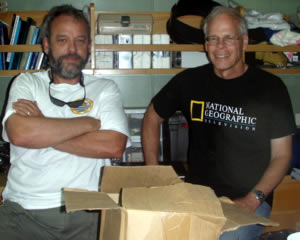
Greg Stone prepares for the expedition with Larry Madin, Director of Research at WHOI. credit New England Aquarium
A serious scientific expedition to explore the ocean will also have an unusual and poignant literary twist. In mid-September, Dr. Greg Stone of the New England Aquarium in Boston will be leading an expedition to investigate the underwater mountains of Sea of Cortez off the Mexican coast. On board, the research vessel Argo will be oceanographers, submarine operators, underwater photographers and all kinds of technical staff to insure the safety of the explorers. But also on board will be Wendy Benchley, the widow of the late writer Peter Benchley whose suspenseful novels usually had adventurous oceanic settings.
In the early 1980's, Benchley wrote the bestseller, The Girl of the Sea of Cortez, which is the lyrical tale of a young woman who has a special love and unique understanding of the ocean. Each day, the protagonist paddled her boat into the open sea, anchored over a submerged volcano, and dove in the rich waters above a seamount. Over time, she learned a mythical secret.
Expedition leader Greg Stone, who had been a close friend of the author for decades, clearly remembers Benchley's inspiration for the book after he had returned from a diving trip to the Sea of Cortez. "Peter was so enthused about what he had seen. The marine life was overwhelming. He had even hitched a ride on a giant manta ray. The entire experience became the basis for "The Girl of the Sea of Cortez", which was really a fable and a dramatic literary departure for Peter. But it was his favorite of all the books that he had written. On that voyage, he really touched the ocean in an intimate way."
A quarter century later, Stone is returning as a scientist to the literary inspiration of Benchley's novel. But in a poignant closing of one of life's circles, Stone has invited Benchley's widow, Wendy, to join the expedition. Science does not often meet the arts, but the coincidence of leading an ocean expedition to the remote site and inspiration for a great friend's novel was too much for Stone to ignore. Since her husband's death, Wendy has been active furthering her husband's legacy as an ardent ocean conservationist, particularly for sharks.
From September 11 to 17th, the expedition will explore and document the rich diversity of marine life of the El Bajo Seamount located between the Baja Peninsula and the Mexican mainland. Expedition members will use a small research submarine that can dive to 1500 feet to investigate the little-known deep water life along the steep sides of these underwater mountains. Divers will also closely examine the seamount's summit which rises to just sixty feet below the water's surface.
Seamounts are ecologically vital habitats where the whole web of ocean life seems to converge. For marine scientists, seamounts are biodiversity hotspots. In the open ocean, a seamount can be an oasis of rich, unique and complex marine life. They have not been extensively studied and are facing greater human exploitation.
Much of the Sea of Cortez is remote and rich with marine life. Pacific grey whales use it as a winter nursery for their calves. Hammerhead sharks gather there in huge numbers. The foundation for the area's rich food web are sardines and anchovies. They attract giant schools of tuna and all kinds of sport fish that have set many world records.
The Sea of Cortez has a haunting beauty that has long intoxicated its human visitors. Before Benchley's novel, John Steinbeck cruised its waters in 1940 and wrote the popular A Log from the Sea of Cortez. The expedition's members hope to have a similar literary inspiration and hope to post daily on an expedition blog that will be available at http://www.neaq.org
Also on the expedition will be Brian Skerry of Uxbridge, Massachusetts, who is one of the most accomplished underwater photographers in the world. Skerry will capture the images while Stone will write the narrative for a future National Geographic article on the ocean's underwater mountains.
